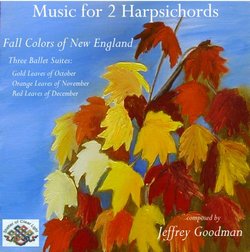| All Artists: Jeffrey Goodman Title: Music for 2 Harpsichords: Fall Colors of New England Members Wishing: 0 Total Copies: 0 Label: Shelter of Clear Light Release Date: 1/20/2009 Genre: Classical Style: Number of Discs: 1 SwapaCD Credits: 1 UPC: 884502011487 |
Search - Jeffrey Goodman :: Music for 2 Harpsichords: Fall Colors of New England
 | Jeffrey Goodman Music for 2 Harpsichords: Fall Colors of New England Genre: Classical
In December of 2008 Shelter of Clear Light Music received an anonymous letter that contained the music manuscript and the story of the music offered here. The letter in part reads:We drove to a narrow road that skirted the... more » |
Larger Image |
CD Details
Synopsis
Product Description
In December of 2008 Shelter of Clear Light Music received an anonymous letter that contained the music manuscript and the story of the music offered here. The letter in part reads:We drove to a narrow road that skirted the Shawungunk Mountains and stopped at a place where a plaque marked the original location of the cabin. We trekked along the still running stream nearby and after an hour or so came upon two large granite stones that fit the description in the note. Using a small shovel, we began digging, and, at exactly 24 inches depth, the shovel uncovered a solid, rusting, but still largely intact, iron box. We brought it up and after tapping it several times with the shovel, were able to open it. Within was no treasure, but it did contain a thick folio of parchment, completely sealed in wax. With great excitement we went back to the antique store where the owner carefully opened it. It read: " I write this in my native English language, so that the French speaking people of the town cannot read it, should they find it. It is a record of something so amazing that were I to tell it to a single soul, I am sure I would be completely ostracized or even worse. The year was 1689 when I came upon the two ancient Red Oak trees. They were noble giants, about 5 feet in diameter and perhaps 100 feet tall. They had been hollowed out by a lightening fire and badly burned, but somehow still had many branches bearing leaves far above the burnt out trunk. Everything was oddly burned away except for an intact semi-circle of the trunk. A thin, almost horizontal piece of wood remained. I tapped the wood and it immediately resonated with the sweetest tone imaginable. Both trees, within an arm s length of one another, had been burned in a similar way. The second tree s horizontal piece of wood also resonated, but the tone was an almost perfect octave lower than the tone of the first tree. I came every day during October, November and December. Just to listen. The slightest wind, even a single leaf dropping, or a bird landing, would start the resonance. Numerous small branches, of different lengths and thickness, would vibrate with sweet and wild melodies each time the sounding boards of the trees were activated. Their music is of course unlike anything of our music of today. No minuets, passepieds, sarabandes, allemandes or gigues. No courantes or bourrees. The music changed moment by moment, would start and stop, then rush ahead, only to disappear into silence. As the leaves changed colors from gold to orange to red the music also grew more wild and intense. At times it was playful and teasing. Then without warning the trees would throb with vibrant intensity as the wind whipped the branches. Flocks of leaves would fall to the ground and just as suddenly swirl upward again as if seeking their place in heaven. Before coming to America, I was fully trained by my father in musical arts. So each night, after spending the afternoon by the singing trees, I came to my harpsichord and tried to notate what I had heard that day. Although very difficult, here within these parchments, are 30 pieces for two harpsichords. There 10 pieces each for October, November and December. I am not sure what this all portends, but when I play them I am at times transported back to the forest, and hear the wild music of the trees, their shimmering leaves, the ebb and flow of the wind, and the birds harbinger songs of the coming winter." So ended the letter that came with the music manuscript. The anonymous traveler who sent the package wishes his identity to remain hidden. Much more could be said about the music itself, but now is the time for the music to speak for itself.

 Track Listings (30) - Disc #1
Track Listings (30) - Disc #1